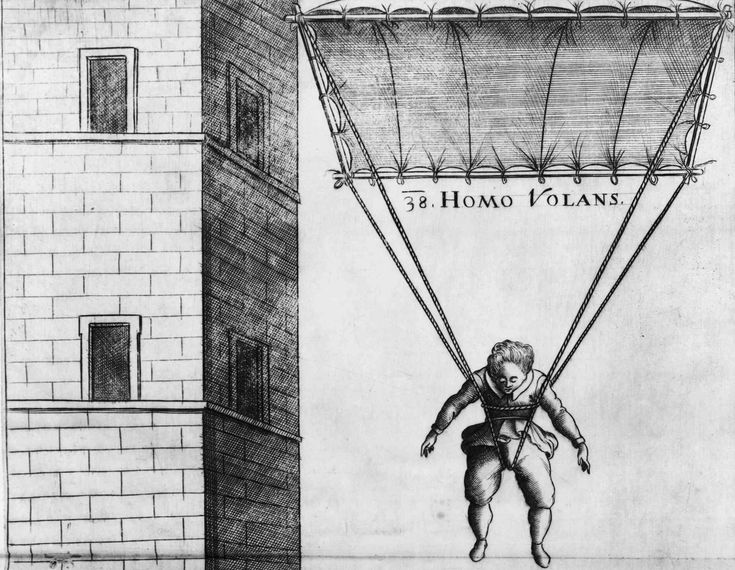History of the parachute: Who invented the first parachute and when?
It is said that the first real parachute was invented in 1783 by the Frenchman Sebastien Lenormand. Sebastien Lenormand was the first inventor to explain the parachute principle.

But the history of the parachute goes back to Leonardo Da Vinci, who thought of the idea centuries ago and sketched a pyramid-shaped parachute.
The first parachute was designed and tested by other inventors before Sebastien Lenormand. Croatian scholar Fausto Veranzio, for example, made an invention based on a drawing by Da Vinci.
Wanting to showcase his invention, Veranzio jumped from the Venetian tower in 1617. Veranzio then detailed the parachute skeleton and published it in "Machinae Novae", in which 56 advanced technical constructions are described in text and illustrations. Veranzio named his parachute "Homo Volans" (Flying Man).
A few years after Sebastien Lenormand's surviving incident in 1783 by throwing himself into space with a parasol, another Frenchman, Jean Pierre Blanchard (1753-1809), made an interesting parachute experiment. In 1785, he dropped a dog, which was parachuted to a balloon in the air, in a basket. He is the first person to find an emergency parachute.
Blanchard claimed in 1937 that he had parachuted out of a bursting hot air balloon. But there were no witnesses. However, Blanchard developed the first foldable parachute made of silk. Up to this point, all parachutes had rigid skeletons.
Andrew Garnerin became the first person to jump with a parachute without a skeleton in 1797. Garnerin jumped out of a hot air balloon at a height of 2440 meters. Garnerin also reduced sway by designing the first air vent in a parachute.
When the parachute of Parisian Andrew Garnerin (1769 – 1823) opened, it took the form of a large umbrella with a diameter of about 9 meters. It was made of cloth and attached to the hydrogen balloon.
Here are some little-known facts about parachutes:
In 1837, Robert Cocking became the first person to die from a parachute accident.
In 1887, Thomas Baldwin invented the first parachute belt.
In 1890, Paul Letteman and Kathchen Paulus invented the method of folding or packing a parachute into a backpack to be worn on a person's back.
Kathchen Paulus, on the other hand, developed the separation mechanism; The small parachute that opened was disconnecting the main parachute.
Two paratroopers claim to be the first to jump out of the plane. Both Grant Morton and Albert Berry parachuted out of an airplane in 1911. In 1914, Georgia "Tiny" Broadwick made her first free fall.
Parachute sport
Skydiving first became a common practice in the 1960s with the design of new "sport parachutes". The sport version offered greater stability and horizontal speed. The traditional round design was replaced by the rectangular design seen today. The round parachute was made of nylon and was collected in a package and connected to a network of cables worn by the user. More advanced nylons with low porosity were used in the rectangular design and the speed of the parachute was doubled.
